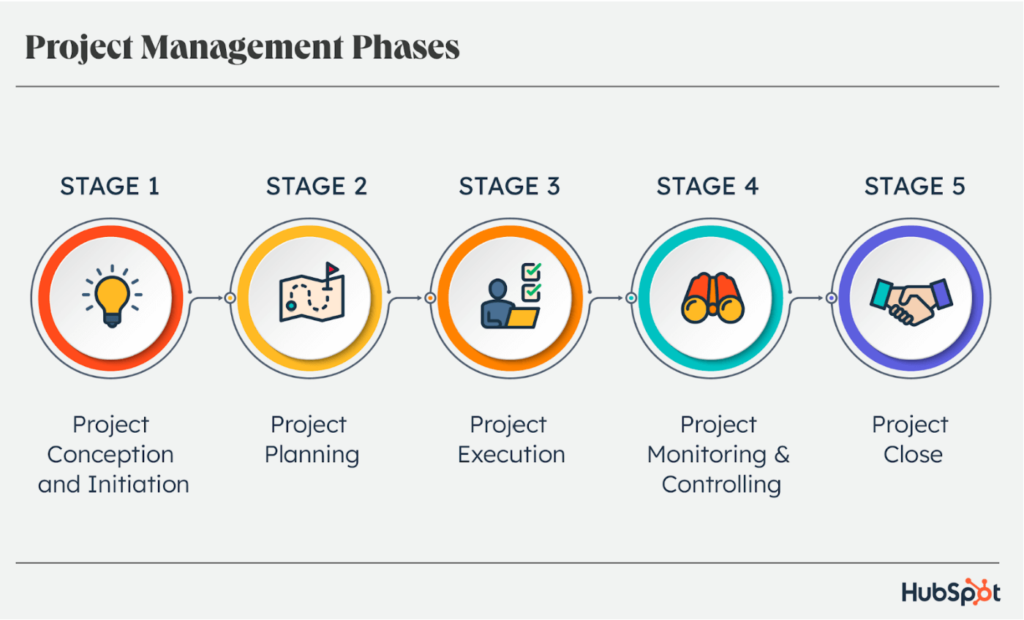Exceed your launch goals, deliver projects faster, and take on more clients - without touching a single tool
See what's possible with this FREE interactive walkthrough.
Choose Your Adventure
Browse by Category
Search the blog & press enter
I'm your Chief Systems Officer. I take your complex problems, and find ways to simplify them. With both a background in Project Management and Business Analysis, I'm able to identify processes in your business that are either slowing you down, or negatively impacting your client's journey and experience with you.
Hi I’m Ashley!

Do you have a project management plan? Even solopreneurs have projects they need to execute and it would be worth looking into a project manager to assist. Whether it’s a new launch, organizing an event, or improving processes, the stages of project management need to come into play.
So what does that look like? After working with several CEOs during my Chief Systems Officer VIP Day, I know what it takes to complete a project successfully. I want to share the five stages of project management to give you an idea of what you’re getting into! Trust me – this process is proven to work with any kind of project. I hope it helps set some expectations for what’s to come and streamline your project!

1. Initiating
Every project starts with an idea and stage one is about making that idea come to life. You’ll create a complete business plan to get your idea planned out.
During the initiating phase, you will put together a team to plan and execute the project. Teams will vary based on what’s needed for the project. Finding the right people for the job can be the difference between your vision coming to life or a project failing. Take the time to assemble your dream team! This is an example of what your team job roles could entail:
- Project manager: Manages day-to-day operations and ensures the project is staying on track.
- Business analyst: Collects necessary data and manages project management tools needed to complete the project.
- Team members: Assigned specific tasks to complete during the project. This could include developers, graphic designers, copywriters, social media managers, engineers, etc.
This is the time to set the timeline and budget, too. Your project manager can assist with this part since they’ll be overseeing the progress.
2. Planning
The next step is project planning. Phase 1 (Initiation) is defining the project on a broad level, but now it’s time to determine the details. This is mainly the project manager’s responsibility. They’ll create a detailed plan for the next three stages of project management.
First, they will create S.M.A.R.T. goals so there’s no room for misunderstanding among the team. The plan will also include milestones and deliverables, and the timeline of when those should be completed. It should break down who is doing what by when. The plan ensures everyone is aligned and working towards the same goals.
The business analyst can assist the project manager with creating a communication plan and a risk mitigation strategy. It’s recommended to have these so the project doesn’t get delayed in the case of worst-case scenarios.
The project manager will also set up and begin to utilize project management tools like ClickUp, Trello, Asana, or SmartSuite. They’ll add all necessary team members, and begin assigning tasks and due dates. This is a great way to communicate about the project, too, because it doesn’t overflow people’s inboxes. Everything is in one place and if someone has a question about the project, they can find details in the tool.
3. Executing
It’s now time to execute the plan. This is when the work gets done and will likely be the longest of the stages of project management. Team members are executing their assigned tasks and the project manager is overseeing the progress.
The project manager is also responsible for communicating the progress with stakeholders. In the case of setbacks or obstacles, the project manager reallocates resources to assist and keep the project as close to the timeline as possible.

4. Monitoring
Monitoring is usually happening at the same time as the executing phase. The project manager supervises the progress being made in the project management tool. They can step in to help when needed and follow up with team members regarding their tasks. If any issues come up, they can work with the team to resolve them with minimal impact on the project timeline.
The project manager will also update the plan as needed. If there’s a major issue that impacts the project completion date, this person will adjust timelines accordingly. With any project, things will come up. It’s important to be flexible and plan for unexpected circumstances ahead of time.
Project managers will also monitor the progress towards KPIs and budget allocation. The stakeholders should communicate expected KPIs at the beginning of the project and it’s the project manager’s job to make sure that happens. They should also ensure the budget is being allocated optimally.
5. Closing
Finally, the project is completed and the project manager delivers it to the client or stakeholder. The stakeholders will approve the project and that’s that! The team members have completed their responsibilities and are done with the project.
However, the job isn’t done for the project manager. They should review and reflect on the project. Here are some questions to consider:
- What went well?
- What didn’t go well?
- How could we have planned better?
- Was the timeline and budget realistic?
- What were some areas of contention and how could we have avoided them?
- Did we have all the team members we needed?
- Did the project management tool work well?
By reflecting on these questions after the project has been completed, you can improve performance on the next project. Each one should get better and better!
Project management is a team effort. It takes a strong team to get the project to completion and make it a success! My on-demand project management service can help you reach your business goals. It’s perfect for busy CEOs looking to scale their businesses to the next level with processes and tech that grow with them. Inquire today to start streamlining your workflow!
About Solution Integrators
To keep it simple, I’m Ashley, a Chief Systems Officer. I take your complex problems and find ways to simplify them. My goal isn’t just to save you time (saving you time is the easy part!) – I want to fully level up the way you interact, manage, and fulfill offers for your clients. I want to help you provide a cohesive experience. An experience that not only feels like quality but looks that way, too. From onboarding to offboarding – I want to transform each phase of interaction from lead to signed client. Let’s work together!
Related
Site Credits
Privacy Policy
Terms and Conditions
© solution integrators 2025
Get actionable biz systems insights, templates, and strategies delivered weekly - designed for service providers who want to streamline, scale, and stress less.
the goods newsletter
Helping motivated industry experts who want to achieve their next revenue milestone with simple systems, a supportive team, and a seamless client experience.